Source: Heart of the Metaverse
According to the Washington Post, Pika Labs, an AI video generation startup founded by Chinese entrepreneur Demi Guo, has completed a round of financing of approximately US$80 million, with a post-financing valuation of approximately US$500 million, and the financing list also includes almost half of Silicon Valley.
Compared with the AI video products that have received financing before, Pika's financing amount is undoubtedly at the top of the list. What is the charm behind this startup that has only been established for more than a year?
01.1 minute project overview
1. Project name: Pika Labs
2. Establishment time: April 2023
3. Product introduction:
Pika Labs' main product is Pika 1.0, which can quickly generate various styles of 3D animations, animations, cartoons and movies based on user text or image input. 4. Founding team:
Demi Guo, Chenlin Meng: PhDs from Stanford University AI Lab
Karli Chen: Master of ML&CV at CMU, former engineer at SenseTime
Matan Cohen Grumi: Creative director, TV commercial director
5. Financing:
In December 2023, Pika Labs received $55 million in financing, including pre-seed and seed rounds, as well as Series A financing led by Lightspeed Venture Partners;
On June 5, 2024, Pika Labs raised another $80 million in financing, with a valuation of $470 million.
02. Empowering creativity and simplifying creation
The digitization of the era is inevitable, and content creation and consumption have become an extremely important part of our daily lives. Among them, video, as the most intuitive and vivid form of media, is growing at an unprecedented rate in terms of production and sharing.
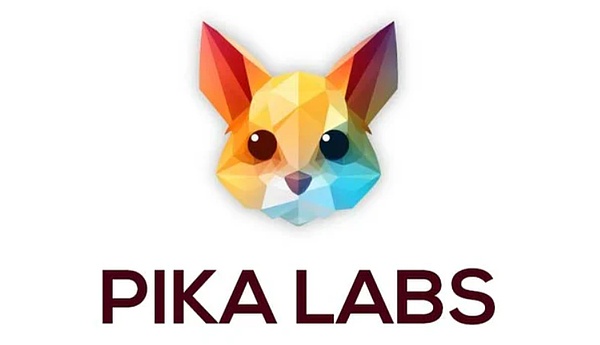
Demand creates applications. It is in this context that Pika Labs was born, bringing a subversive innovation to the traditional video production process.
The latest news shows that Pika Labs has successfully obtained $80 million in financing. This figure not only represents investors' high recognition of its technical strength and market prospects, but also their firm confidence in the future development of Pika Labs.
The founding team of Pika Labs is very simple, with only four young people.
The core members are Demi Guo and Chenlin Meng, doctoral students of Stanford University's AI Lab, and two other creative technical members. Adhering to the original intention of "empowering creativity and simplifying creation", this "small and beautiful" startup began to develop Pika.
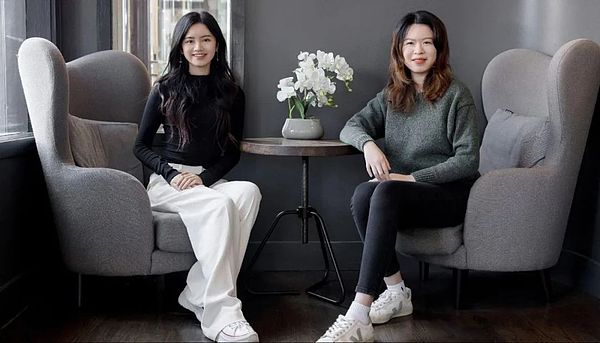
Pika Labs wrote in its official introduction: "By providing easy-to-use and powerful tools, we inspire more people's creative potential and help them transform their ideas into visual works."
Based on the above, Pika Labs, which was established just over a year ago, has not only attracted the attention of many users, but also won the favor of the capital market. Investors have extended olive branches and provided strong financial support for the company's continued innovation and rapid growth.
03. "ChatGPT" in the video industry
Pika Labs has a top text-to-video platform that can directly transform creative concepts into visually engaging videos. The platform provides innovative features such as Img2Vid and Text 2 Video, which simplify the user's video creation process and improve the quality and efficiency of video generation, making Pika labs highly competitive in the field of text-to-image video.
Core product: Pika1.0 model
Pika's core product is the Pika1.0 model, which is an advanced AI video generator.
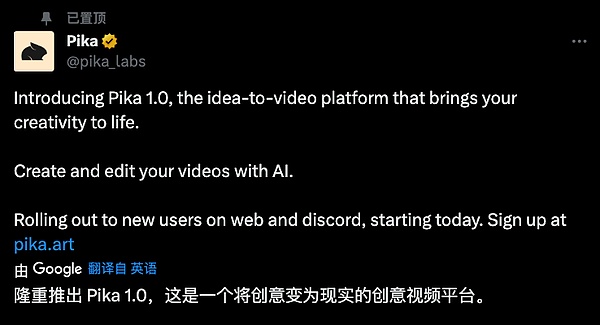
Earlier, Pika Labs released the Pika beta model, which could only generate ordinary 2D animations. Pika Labs released the Pika1.0 model in a short period of time with only one iteration, achieving a huge upgrade in video effects.
Pika1.0 can generate videos of various styles and types, such as 3D animations, live-action clips, anime or movies. These movie-level scenes, which are generated only by models and have a sense of real shooting, can present exquisite details, perfect lighting effects and diverse camera switching.
However, the charm of Pika1.0 is not limited to this.
Its biggest breakthrough is that it supports users to edit and modify videos in real time. Specifically, after generating an original video, if the user wants to modify part of the video, he can enter a short command again to modify the fixed or moving objects.
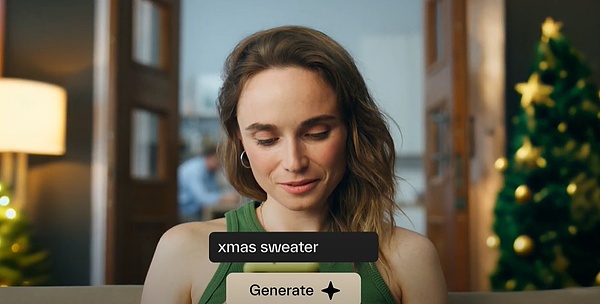
In addition, Pika1.0 is now available for everyone to use for free.
Simple and efficient use process
In addition to Pika1.0 supporting online generation of AI videos on both desktop and mobile web pages, the web interface is equipped with an easy-to-use dialogue interface (similar to ChatGPT).
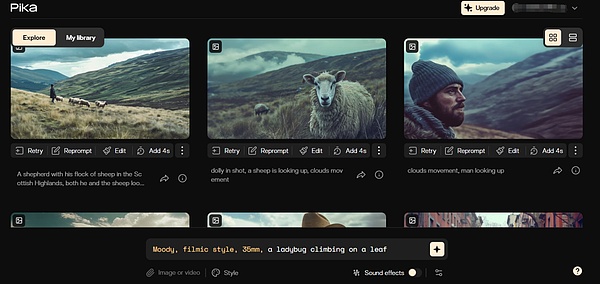
Users visit the official website of Pika Labs and click "Try Pika" in the upper right corner to jump to the Pika1.0 web interface. Then register through Google or Discord account, and you can directly use all functions. Currently two methods are supported:
1. Generate video directly: enter /create, then enter prompt to get the video.
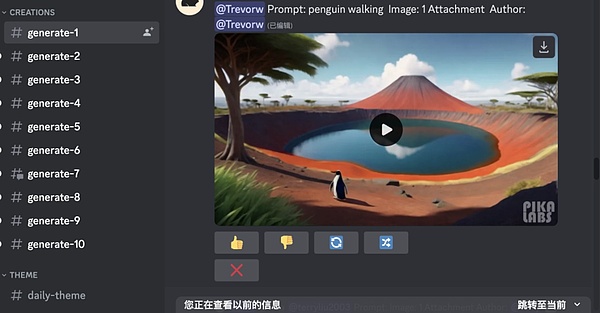
2. Generate video from image: use MJ/SD to generate image (optional) + add prompt on Pika platform = get video.
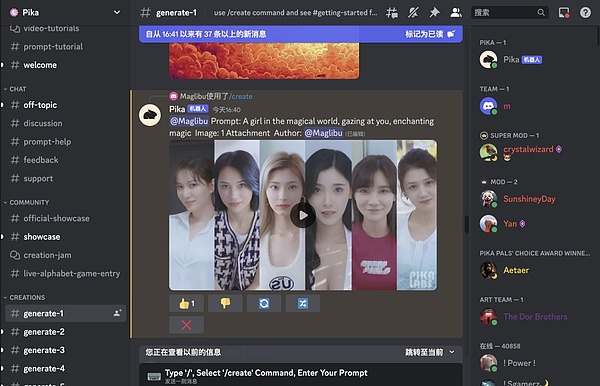
The Pika1.0 model currently achieves the quality and accuracy levels that only professional video creation can achieve. In addition to text/image videos, Pika also supports the following advanced features:
Extend videos to any length/modify content: Increment by 4 seconds at a time, unlimited to any clip. Instantly modify aspects of any video with inline drawing, such as adding another character or changing someone's clothes.
Style transfer: Convert existing videos to other styles, including differentiated characters and objects, while maintaining the structure of objects in the video.
Extend video canvas: Expand the canvas or aspect ratio with external drawing. Change the video from the 9:16 vertical screen size of existing video platforms to the widescreen 16:9 format, and the AI model will predict content that exceeds the boundaries of the original video.
Adjust camera movement: Adjust motion elements in real time, including camera pan, tilt, zoom, and motion intensity.
04. The future of video creation
It is not easy for Pika to occupy a place surrounded by competitors such as PixVerse, Runway, Genmo, and Haiper. As a startup, it is indeed proud of its remarkable achievements in a short period of time, but this young technology company is not stopping there. On the contrary, they are actively planning the next development blueprint. The company's founder said that it will continue to deepen its efforts in the field of video generation, hoping that Pika can turn anyone's vision into reality.
Expand the depth and breadth of technology
Pika will further optimize its artificial intelligence algorithms to improve the accuracy and intelligence of video generation. Through deep learning and natural language processing technology, Pika's tools will be able to better understand user needs and generate more relevant video content.
Model advancement: Pika will continue to optimize and upgrade its AI video generation model, using more advanced algorithms and larger data sets for training to improve the model's generation capabilities, stability, and efficiency. For example, referring to OpenAI's Sora model, Pika can explore the possibility of generating longer and higher-quality videos.
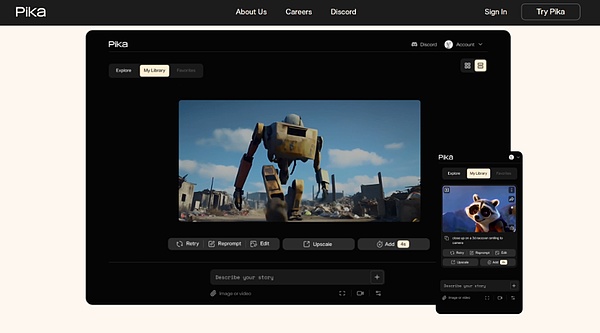
Functional uniqueness: In addition to the existing video style generation and editing functions, Pika will also explore more innovative functions, such as more sophisticated video editing, dynamic scene generation, emotional expression, etc., to meet users' diverse needs for video creation. Pika has dubbing effects and lip-syncing functions, Runway has a brush control function, Dreamina has a good dynamic effect, Domo has a better transfer effect, etc., and unique functions are the key to Pika's standing out among many video generation tools.
Human-machine collaborative creation mode
In the era of AI creation, the field of video generation will usher in a profound change. This change will not only be limited to the technical level, but also a subversive reshaping of content creation, dissemination methods and even the entire social culture.
Although AI algorithms can automatically generate video content, human creativity and imagination cannot be replaced by AI. Therefore, future video creation is likely to adopt a human-machine collaborative mode, and human creators and AI algorithms will jointly participate in all aspects of video creation.

Human creators can give full play to their creativity and imagination to provide ideas and inspiration for AI algorithms; while AI algorithms can quickly generate high-quality video content according to the guidance and requirements of human creators. This human-machine collaborative creation mode will make video content richer, more diverse and innovative.
With the advent of the AI era, the diversity and personalization of video content will be further enhanced, which will help to better express and spread social culture, values, etc. At the same time, AI algorithms can also be adjusted and optimized in real time based on user feedback and preferences, making video content more in line with user expectations and needs, thereby promoting the development of social culture.
Of course, AI video generation also faces some challenges in its development process. How to ensure the quality and originality of the video, how to balance technological development and privacy protection, and other issues still require joint efforts from all parties in the industry to solve.
Reference Links:
1.https://pika.art/home
2.https://venturebeat.com/ai/pika-labs-text-to-video-ai-platform-opens-to-all-heres-how-to-use-it/
3.https://lsvp.com/stories/pikas-imagination-engine/
 WenJun
WenJun
















